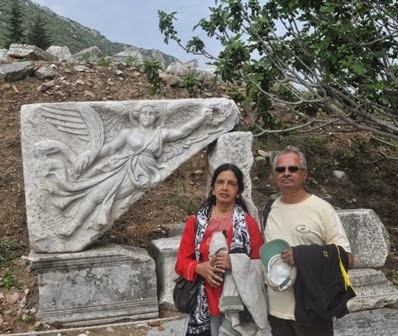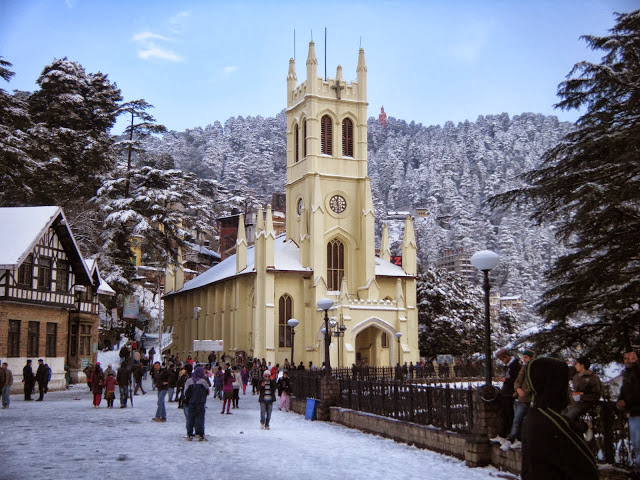SHIMLA
Shimla
needs no introduction. It was the summer residence of Viceroys of India during
the British rule and is now the Capital of Himachal Pradesh We spent four days in Shimla in the month of September
2013.
KALKA –SHIMLA RAILWAY LINE
After
a couple of days in Chandigarh on 19th Sept, we took the Himalayan
Queen train from Chandigarh to Kalka, a journey of about an hour. At Kalka we
boarded the Kalka – Shimla Himalayan Queen,the Toy Train. It travels at a speed
of about 25-30 Kms and takes 5h 30 mts to reach Shimla. The travel by this train meandering around hills
and valleys through the alpine country is a life time experience.The route has more
than 900 curves and turns, more than 100 tunnels and more than 900 bridges.
There are 20 stations enroute, the most important being BORG.
Some
of the bridges are architectural and engineering marvels. One which impressed
me most was a bridge with two tier arches of stone.
All
details about the railway are on a plaque at Barog station which is the one of
the highest points on the line. Barog is located
at a height of 1560 metres above the mean sea
level. Barog is named
after Colonel Barog, an engineer involved in building the railway track in
1903. Barog was responsible for
designing a tunnel near the railway station. He commenced digging the tunnel
from both sides of the mountain, which is quite common as it speeds up
construction. However, he made mistakes in his calculation and while
constructing the tunnel, it was found that the two ends of the tunnel did not
meet. Barog was fined an amount of 1 Rupee by the British government. Unable to withstand
the humiliation, Barog committed suicide. He was buried near the incomplete
tunnel. The area came to be known as Barog after him.
Later it was completed under Chief
Engineer H.S. Harrington's supervision in a short period from July 1900 to
September 1903, at a cost 8.40 Lakh rupees.
Barog tunnel is said to be one of the
straightest tunnels in the World. This is 1143.61m long and is the longest of
the 103 operational tunnels on the route of the Shimla-Kalka Railway. Barog
station is immediately after the tunnel. Trains take about 2.5 minutes to cross
this tunnel, running at 25 kilo metres per hour.
The ancient Neals Token Instrument
System of communication and track control is still followed here. This involves
exchange of tokens at all stations on the route to get line clearance. This
must be probably the only route in India following this system. This route has
now been given the status of World Heritage Site by UNESCO. Climbing from Kalka
at 656 Mts above MSL to Shimla at 2076 Mts above MSL in a distance of 96
kms,.has also been a Guinness World Record.
SHIMLA
We were greeted by an excellent
weather, neither cold nor hot. A very peaceful place where things move
leisurely. Extremely clean and neat place. No plastics. You have to carry paper
or cloth bags for shopping. Taxis are available to take tourists to all places
of interest .We tried to walk to most of the places as we had plenty of time at
hand. There is the Mall road typical of all hill stations. Apples, Pears and
Kiwis (grown locally now) were available in plenty and were very cheap.Rs.25 to
30 per Kg. Most of the hotels are off the main roads and one has to negotiate
some steep roads to approach them.
The Ridge, Christ Church, Mall Road,
Scandal Point( the place from where the Maharaja of Patiala kidnapped the
daughter of the British Viceroy in 1892),Kali Bari , Jakhho temple(a 108 ft
high statue of Hanuman is erected here) ,Budhist Monasteries are some of the
attractions of Shimla.
GAIETY
THEATER
One attraction which caught our
attention is the Gaiety Theater.
Today’s
Gaiety Theatre is the stump of the once colossal edifice that was the Town
Hall. It was opened on the 30th of May, 1887, Queen Victoria's Jubilee Year and
its God Father was Lord Bill Beresford. The formal inauguration of the club
took place in the year 1888 and since then plays have been staged in the Gaiety
with unfailing regularity. The Simla Amateur Dramatic Club was managing the
theater The history of the club goes back to the times when theatre was looked
upon as a major and serious source of entertainment and, therefore became a
cultural necessity for the English elite. Hence, Shimla became the home of
amateur theatre and the Gaiety Theatre produced the best of the plays performed
in London. In 1911, the upper portions of the building were dismantled as the
structure was found to be unsafe
Among the
leading theatre personalities connected with the Shimla Amateur Dramatic Club
are: Field Marshal Lord Roberts, who remained president of the Club from
1891-1892 during his tenure as Commander-in-Chief of India; Major P.H. Dnyer, a
distinguished producer and actor who acted in Loyalties, Interference and Mary
Rose; Lord Bill
Beresford, V.C. who was the Military Secretary to Viceroy Lord Lytton, famous
poet and author Rudyard Kipling, Lord Kitchner, Mrs. Deane, Major General Sir
Godfrey Williams, the Chief of Scouts, Colonel Baden-Powell, and Sir Dennis
Fitz Patrick, Lieut-Governor of Punjab during 1895 and many others. Notable
film personalities like K.L. Saigal, Prithvi Raj Kapoor, Shashi Kapoor,
Jennifer Kendall, Raj Babbar, Anupam Kher, Manohar Singh, Nasseerudin Shah,
frequently performed on the stage of the Gaiety theatre.
The theater has been renovated from 2004 to 20/9, with the
original structure untouched to keep its heritage preserved while making it
more attractive. Sanjana Kapoor, theater personality (daughter of actor Shashi
Kapoor) and Anupam Kher(who belongs to Shimla) took active role in the
restoration. The restored theater is adorned with
beautiful paper mache panels, reminiscent of the old colonial era. The stage is
equipped with unique curtain arrangement having sand bags and pulleys, and natural
acoustics. It has a seating capacity of 320 persons in two levels. Anupam Kher
has conducted some theater workshops and plans to hold a theater festival
shortly.
Visitors are attracted not just to its architecture, but also to the
rare British photographs of plays staged from 1894-1904 and British era drama
scripts housed in the historic building.
The Gaiety
Dramatic Society (GDS), which now manages the theatre, has also acquired
scripts of about 400 plays. These include 108 scripts of original English
plays that were once staged by the British. Some rare books on
stagecraft and theatre of the British are also available in the theatre's
library.
The
management has recently started guided tours of the theater















No comments:
Post a Comment